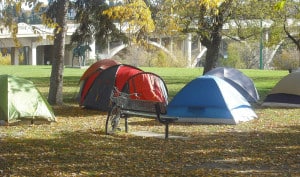
Occupy Saskatoon offered homeless people safety, food.
Since the first protesters took to the streets of New York’s financial district on Sept. 17, the Occupy Wall Street movement has spread to more than 1,500 cities worldwide. About 1,000 cities with active Occupy protests are much farther south, in the United States, allowing the Saskatoon protesters to develop distinctly local priorities.
Chief among these were the homelessness and housing issues that have long plagued the city. Since 2007, rental rates have increased by 16.2 per cent, and rentboard.ca places the average cost of a two-bedroom apartment in the city at $1,119 per month. For a single-bedroom apartment the cost is $879.
High rent could be a bigger factor in homelessness than employment. A 2008 study of Saskatoon’s homeless found that more than two thirds of homeless people in town were employed, and of those, 70 per cent were employed full time.
“If anything, that number has increased since 2008,” said DeeAnn Mercier. Mercier works at the Lighthouse, a local non-profit that provides both transitional and long-term housing for the city’s homeless and poor populations.
“Housing has become much more expensive, rent has increased and vacancy rates are very low.”
The Occupy Saskatoon camp, like many others in the movement, was open to everyone who wanted to be involved. In a matter of days, some of the city’s homeless population had migrated there in lieu of sleeping alone as the weather turned cool. With a community of tenters and food being served, the camp offered homeless people a safer, warmer place to stay.
Ryan Desjarlais told the CBC earlier this week that he originally took up staying at the Occupy Saskatoon camp because of the fire and food, but that he supports their protest as well.
Following the appearance of several homeless people at their camp, the Occupy Saskatoon protesters seem to have taken on their plight as a central issue. On Nov. 12, Occupy Saskatoon organized a march against homelessness to raise awareness.
“I’d say it became an issue because it was one thing that touched us directly at the camp, feeding and housing homeless people that came through,” said protester Graham Goff.
However, while Goff was willing to discuss the importance of homelessness to Occupy Saskatoon, he stressed the fact that homelessness and poverty are connected to the larger themes the Occupy movements have honed in on.
Goff said homelessness was indeed “a focus, but it needs to be kept in the context of the larger global system.”
“It’s the end result of a system that distributes wealth unequally,” Goff said. “It really comes down to the systems of power we have in our society, the concentrations of economic power.”
The camp, which moved from Friendship Park to Gabriel Dumont Park earlier this month, broke up on Nov. 14. City officials served an eviction notice despite the fact that the campers had already made public their intention to vacate the park. Nonetheless, the evacuation took place peacefully.
Since decamping on Nov. 17, the protesters have continued to meet and work on maintaining the momentum of their protests. Goff said the group has decided to continue meeting on a weekly basis.
“Out of that camp came very good bonds and friendships,” said Goff, who did not sleep at the camp due to work constraints. “The community that was built there will help us keep going.”
—
Photo: Jordan/Flickr